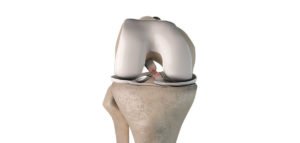The anterior cruciate ligament (ACL) can rupture partially or completely during trauma, most often sports, as a result of a twisting or hyperextension movement.
When it is torn, this ligament can be reconstructed during a surgical intervention carried out under arthroscopy but this operation is far from being systematic and the indications to be operated have been perfectly defined by the High Authority of Health in order to avoid any improper surgery.
Role of the anterior cruciate ligament
To understand the indications for surgery, it is necessary to understand the role of the ACL. This ligament is in fact a “cord” made up of connective fibers stretched in the middle of the knee between the femur and the tibia. Its function is to participate, along with the collateral ligaments and the menisci, in the stability of the knee in pivot movements so that the knee does not slip away. The ACL therefore does not intervene when the knee works in the axis.
Therefore, a torn ACL does not make it difficult to move around in everyday life on flat ground because this ligament does not intervene in these circumstances. On the other hand, during changes in weight bearing and direction that are particularly found in the practice of ball sports or sliding, knee instability may appear. The rupture of the ACL is then responsible for a feeling of “fragility” or even giving way of the knee.
The instability of the knee after an ACL rupture is not systematic, however, far from it, since the collateral ligaments and menisci that participate with the ACL in stabilizing the knee in pivoting movements may be sufficient to maintain it.
Indications to reconstruct the anterior cruciate ligament
Unstable knee
Regardless of the patient’s age, if after an ACL tear the knee is unstable during pivoting movements, there is no other way to stabilize it than to rebuild the anterior cruciate ligament.
Rupture occurring before the age of 30, even in the absence of instability
Knee instability is not systematic after an ACL rupture. However, if the knee remains stable it is in particular thanks to the menisci which, due to the absence of the ACL, undergo much greater stresses with a greatly increased risk of meniscal tearing. However, before the age of 30, the menisci have a very important role because, in addition to participating in the stability, they cushion the impacts that the knee undergoes and thus protect the cartilage from wear and tear, i.e. osteoarthritis. The importance of the menisci physiologically decreases from the age of 30 and after the age of 40 their capacity to absorb impacts is extremely reduced.
Patients under the age of 30 are therefore almost systematically offered to undergo surgery even in the absence of knee instability in order to limit the risk of secondary tearing of the menisci, which is a factor of early osteoarthritis.
After the age of 40, since the role of the menisci in protecting the cartilage is greatly diminished, surgery is not offered to protect them and the operation is only reserved for patients with an unstable knee.
For patients aged 30 to 40 at the time of the rupture, if they are not unstable, it is the discussion with the surgeon that will determine whether it is better to operate or not, taking in particular into account the desire to resume sport and the nature of the sports practiced.
Patient with a “risky” profession
For some physically demanding professions, ACL reconstruction is systematic regardless of the patient’s age or knee stability, in order to prevent the risk of an untimely fall in “delicate” conditions. This is particularly the case with firefighters or the military.
Other indications
Other criteria may be taken into account to refer to an operation when the patient does not meet the indications defined above.
Patients over 30 or 40 years of age with a significant practice of pivot sports can be operated on without waiting for the occurrence of an accident of instability of their knee, in order to avoid a too late esumption of their sporting activity.
The existence of a repairable tear of a meniscus associated with a torn ACL in a patient under 40 years old may also point to the operation which will allow both meniscal suture and reconstruction of the ACL without which the meniscus has little chance of healing.
In summary
Knee stability, age, sports practice, occupation and condition of the menisci are the criteria to be taken into account in determining whether an anterior cruciate ligament reconstruction is necessary. The necessary details will be provided to you during the consultation with an orthopedic surgeon
Discover the operations linked to this article:

Cruciate Ligaments Surgery
Anterior cruciate ligament rupture results in knee instability or the premature wear of the menisci, a potential source of early osteoarthritis in young patients. Arthroscopic reconstruction of the anterior cruciate ligament is a reliable proven method for stabilising the knee, protecting the menisci and enabling a return to the same level of sports activity as before.

